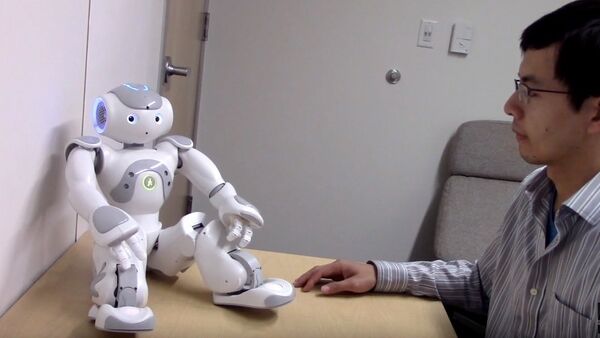Researchers at Stanford University are going to present a paper at the Annual Conference of the International Communication Association in Fukuoka, Japan, in June, titled 'Touching a Mechanical Body: Tactile Contact With Intimate Parts of a Human-Shaped Robot is Physiologically Arousing.'
The authors set out to discover whether groping an automaton in what we could call its "private area" would make people uncomfortable. It did.
People get really uncomfortable when asked to touch robot butts https://t.co/dUk7q4mifP robots are shameless, though pic.twitter.com/SnFhi6KL6c
— Kelsey D. Atherton (@AthertonKD) April 5, 2016
Volunteers were filmed while interacting with a cute NAO robot, a human-like droid manufactured by French firm Aldebaran Robotics.
The talking robots asked the subjects to touch various parts of its body, in what was ostensibly a rehearsal of an anatomy 101 class. Everything went smoothly until the ribald bot requested to be patted on the butt.
When this happened, sensors on the subjects' skin detected an increase in their physiological arousal — i.e. excitement, not strictly sexual in its nature.
Similar results were detected with other parts of the (robo)body, like the pelvic area or the inner thigh. The researchers also noted that the time of response to the robot's commands became longer when the designated to-touch area was one that people traditionally consider private.
Joke if you must, but this study is a major breakthrough in understanding robot UX design. https://t.co/mCUbdszluE
— Annalee Newitz (@Annaleen) April 5, 2016
So, what does this teach us? On a simple plane, that humans are easily gullible. We know that robots are not people and that there is no such thing as robotic private parts, but the simple fact that a machine's structure resembles the human body makes us fret.
"People are not inherently built to differentiate between technology and humans. Consequently, primitive responses in human physiology to cues like movement, language and social intent can be elicited by robots just as they would by real people," the paper reads.
Beyond that, the experiment could be used to understand where it is better to position buttons, touchscreens and other tactile interfaces on future robots. If we are to ever start using robots in retail, hospitality and emergency — as many companies are intending to — we should probably avoid installing their interface on their groin, unless our aim is making people uncomfortable. Hands, for instance, would be safer choices.
The paper also suggests that making robots less anthropomorphic would probably solve the matter once and for all.
"Developers could also be aware that when those norms are violated (for example, a robot that has a humanoid form and that gives social cues like speech and gesture asks the person to touch it in an area that people don't usually touch robots), people may feel uncomfortable about it, so it may be necessary to design around that."


